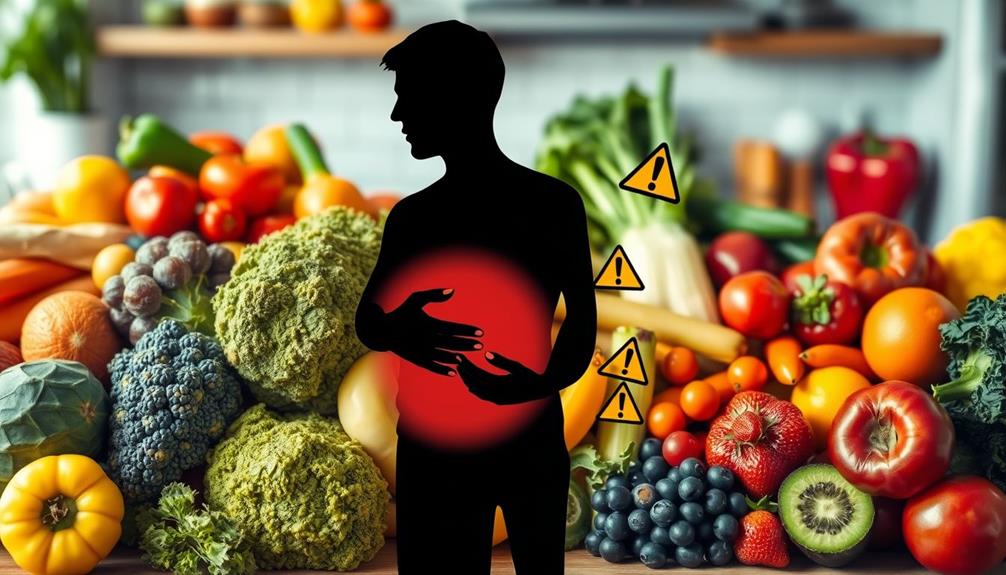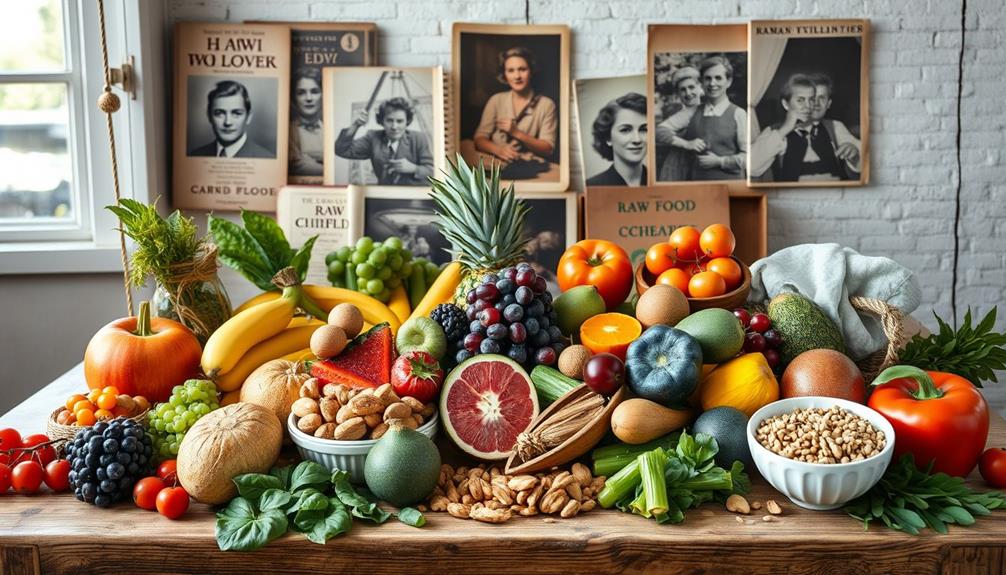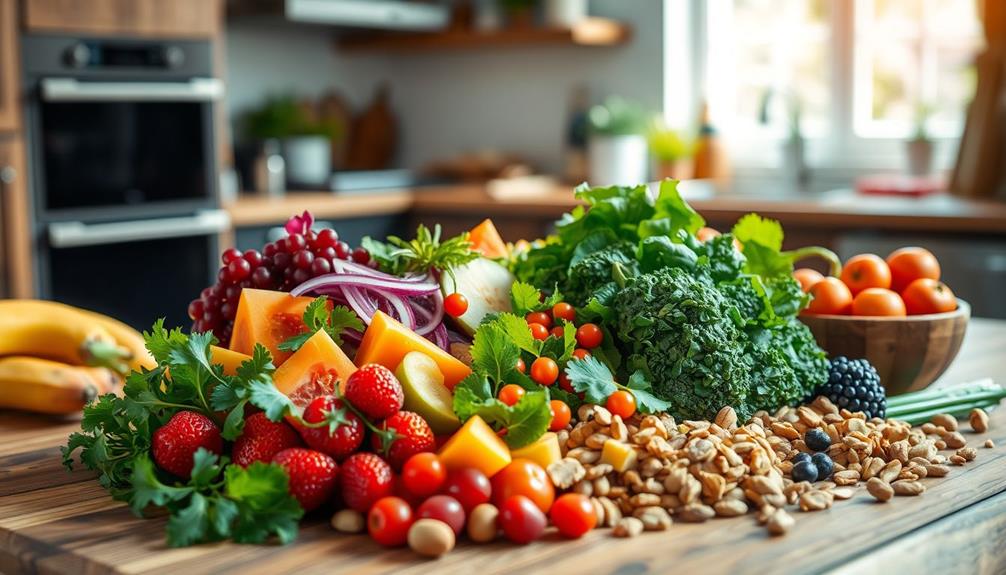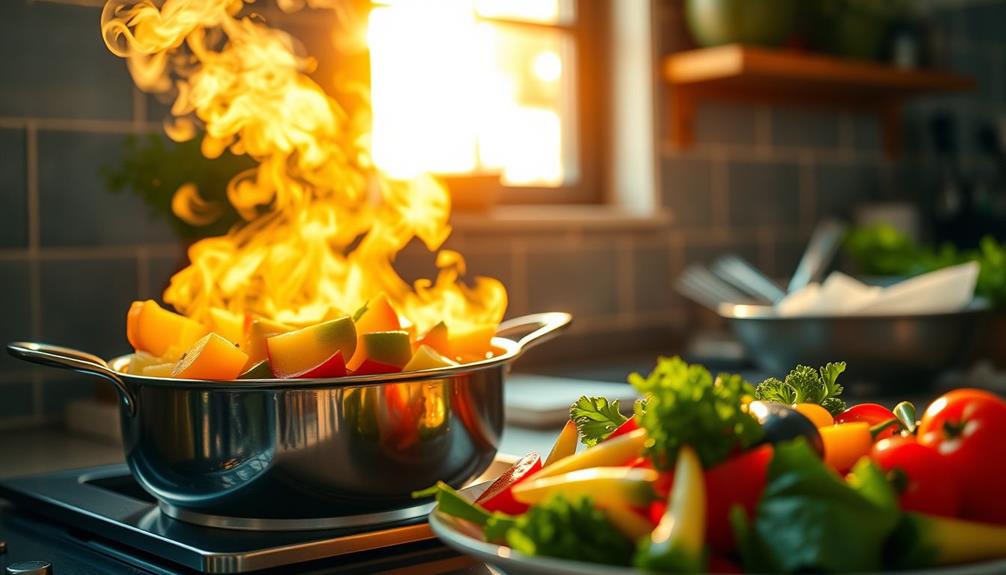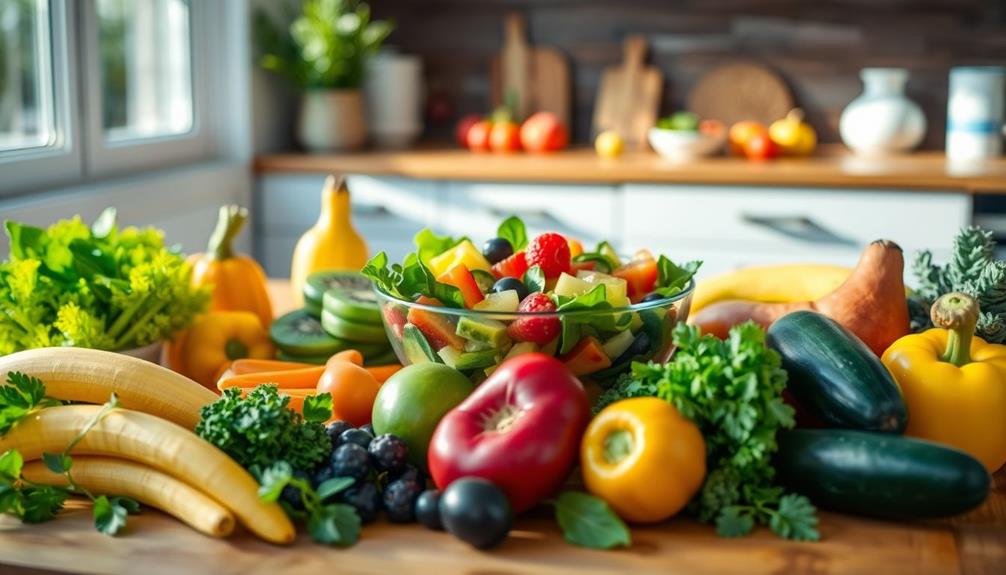Yes, raw food can cause diarrhea in humans due to harmful bacteria and pathogens found in both animal and plant products. Consuming undercooked pork, raw eggs, or contaminated fruits and vegetables can lead to foodborne illnesses. Symptoms like diarrhea, nausea, and abdominal pain often arise within hours of eating contaminated food. High-risk groups, including young children and pregnant women, face even greater dangers. Safe food handling practices, like washing produce thoroughly and cooking animal products to safe temperatures, can help mitigate these risks. For more insights on keeping your meals safe, you might want to explore further.
Key Takeaways
- Consuming raw animal products, like pork and eggs, can lead to foodborne illnesses causing diarrhea and gastrointestinal distress.
- Raw plant foods may harbor harmful bacteria if not washed properly, increasing the risk of diarrhea.
- High-risk groups, such as children and pregnant women, are more susceptible to severe symptoms from raw food consumption.
- Common pathogens associated with raw foods, including Salmonella and E. coli, are known to cause diarrhea and vomiting.
- Proper food handling, including cooking and washing, can significantly reduce the risk of diarrhea from raw foods.
Understanding Raw Food Risks
Understanding raw food risks is essential, especially if you often enjoy dishes like sushi or ceviche. While these meals can be delicious, they come with potential dangers that you shouldn't ignore.
Raw foods, particularly those derived from animals, can expose you to harmful bacteria and parasites, leading to foodborne illness. Individuals with conditions such as Borderline Personality Disorder (BPD) may experience heightened emotional responses to food-related anxiety, further complicating their relationship with eating.
For instance, consuming raw or undercooked pork can result in severe gastrointestinal symptoms due to pathogens like Salmonella and E. coli. Similarly, eating raw eggs poses a significant risk of salmonella infection, which can cause uncomfortable diarrhea.
You mightn't realize that even certain raw plant foods can harbor harmful bacteria if they're not washed properly.
High-risk groups, including children, pregnant women, and those with weakened immune systems, should take extra precautions.
It's vital to recognize the risks associated with raw foods and understand that the consequences can be more severe for vulnerable individuals. By being aware of these foodborne illness risks, you can make informed choices about what to eat and maintain your health.
Pathogens in Raw Animal Products
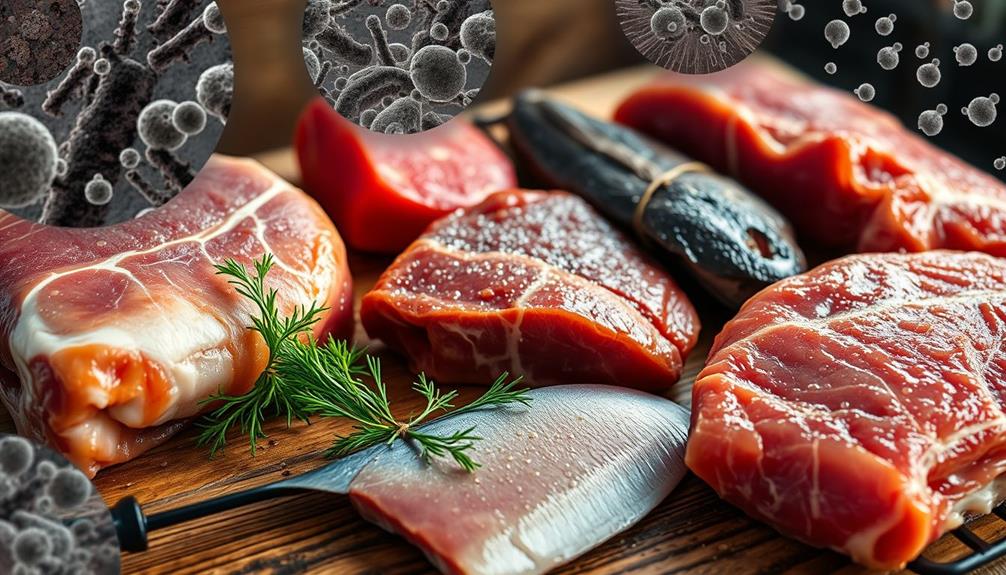
When you consume raw animal products, you're exposing yourself to common pathogens like Salmonella and E. coli, which can lead to serious health issues.
It's important to be aware of your budgeting for food safety when preparing meals. High-risk groups, such as pregnant women and the elderly, need to be particularly cautious.
Understanding the symptoms of infection, such as diarrhea and vomiting, can help you make safer food choices.
Common Pathogens Identified
Consuming raw animal products can expose you to several dangerous pathogens that pose serious health risks. Common culprits include bacteria like Salmonella, E. coli, Listeria monocytogenes, and Campylobacter. When you eat raw or undercooked pork, you greatly increase your chances of food poisoning from these bacteria, leading to severe gastrointestinal distress and diarrhea.
It's important to take into account that certain populations may have higher risks when it comes to foodborne illnesses, similar to how mammography guidelines emphasize the need for tailored health screenings based on individual risk factors.
Raw oysters are another risky option, as they can harbor harmful viruses and bacteria. Consuming them may result in vibriosis or hepatitis A, both of which often cause diarrhea.
If you enjoy sushi or ceviche, be aware that these dishes often contain raw fish, which can carry parasites like anisakiasis. This can lead to gastrointestinal issues and, again, diarrhea.
Don't overlook raw eggs either; they're frequently associated with Salmonella. Eating dishes that contain raw eggs can result in food poisoning symptoms, including diarrhea and vomiting.
High-Risk Groups
Certain groups of people face a higher risk of foodborne illnesses from raw animal products due to their vulnerable immune systems. High-risk groups, including children, pregnant women, the elderly, and immunocompromised individuals, should be particularly cautious.
Consuming raw seafood, like oysters or ceviche, can expose you to harmful bacteria and parasites, which are known to cause severe gastrointestinal issues. Additionally, it's important to be aware of how hamster care and costs can reflect on the safety of food handling and preparation practices.
For instance, eating raw fish can lead to infections that trigger diarrhea and vomiting, especially in these vulnerable populations. Similarly, undercooked pork carries pathogens like Salmonella and E. coli, increasing the risk of foodborne illnesses.
The dangers don't stop there; raw oysters are notorious for harboring viruses and bacteria, such as those causing vibriosis or hepatitis A, which can also result in diarrhea.
Given these risks, it's essential for high-risk groups to avoid raw seafood altogether. The potential for foodborne illnesses from these products is significant, and taking preventive measures can help protect your health.
Always prioritize food safety and consider cooking animal products thoroughly to minimize any risk.
Symptoms of Infection
Raw animal products can introduce a range of pathogens that lead to distressing symptoms. When you consume raw meat, seafood, or dishes like sushi and ceviche, you might expose yourself to harmful bacteria such as Salmonella, E. coli, and Vibrio. These pathogens are notorious for causing foodborne illnesses, which often manifest as severe gastrointestinal symptoms.
Additionally, it's crucial to take into account the importance of selecting safe food options, especially for vulnerable individuals. Following proper food safety guidelines can greatly reduce the risk of exposure to harmful pathogens in your diet, especially from cold medications overview.
If you experience diarrhea and vomiting after consuming raw animal products, it could be a sign of infection. High-risk groups, including pregnant women, children, and those with weakened immune systems, are especially vulnerable to these infections. For instance, anisakiasis from raw fish can lead to acute distress, with diarrhea being one of the most common symptoms.
Additionally, raw pork poses risks due to bacteria like Listeria, which can also lead to food poisoning. The symptoms can be severe and may require medical attention.
To protect yourself, always verify that you cook animal products to the recommended internal temperatures. This practice greatly reduces your risk of encountering foodborne pathogens that cause diarrhea and other gastrointestinal issues. Stay cautious and informed to enjoy your meals safely.
Dangers of Raw Plant Foods
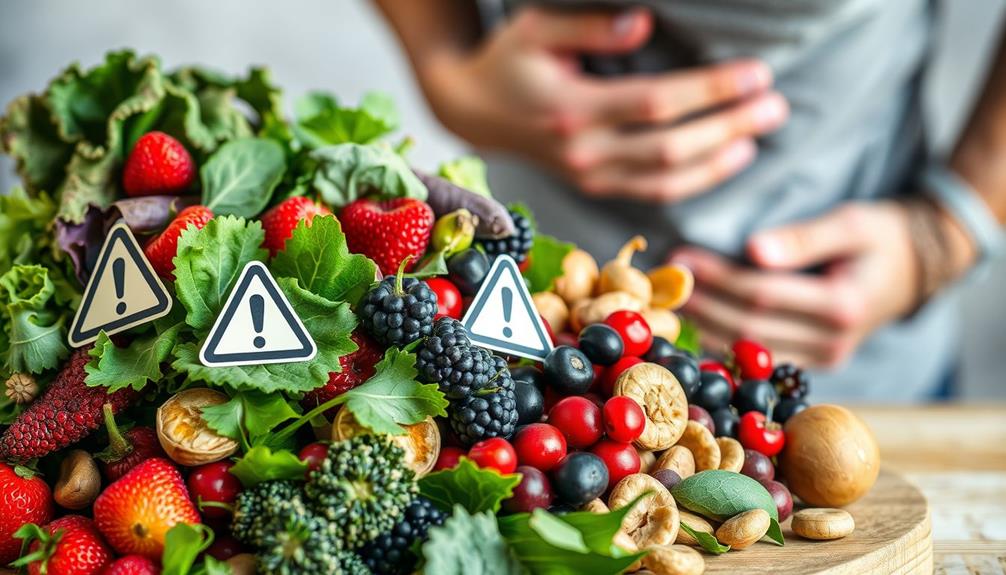
Eating raw plant foods can pose several risks that you mightn't be aware of. One of the main concerns is the potential for harmful bacteria lurking on these foods, which can lead to foodborne illnesses, including diarrhea. If you don't practice thorough washing before consuming raw produce, you're increasing your risk of gastrointestinal distress.
Additionally, practicing proper food storage and preparation techniques, similar to those recommended for mastering the art of bug out bags, can further mitigate these risks.
Certain raw vegetables contain anti-nutrients that may hinder your body's ability to absorb essential nutrients. When consumed in large amounts, these anti-nutrients can contribute to digestive issues.
Additionally, pesticide residues on unwashed raw produce can also cause gastrointestinal problems, further emphasizing the importance of cleaning your fruits and vegetables properly.
Allergic reactions to specific raw fruits or vegetables can occur, leading to uncomfortable gastrointestinal symptoms, including diarrhea.
While many enjoy the crunch and freshness of raw plant foods, remember that cooking can enhance both the safety and digestibility of these foods. By cooking them, you greatly reduce the risks associated with foodborne illnesses that come from eating raw.
Symptoms of Foodborne Illness

When you consume contaminated raw foods, you might experience common symptoms like nausea, vomiting, and diarrhea. These symptoms can linger for up to seven days, especially if you've ingested dangerous pathogens.
Additionally, the impact of foodborne illnesses can vary based on individual development and immune response, particularly in younger children whose key domains of development may affect their ability to recover.
Certain groups, such as children and pregnant women, are at a higher risk for severe complications from these illnesses, making awareness essential.
Common Symptoms Explained
Foodborne illnesses can strike quickly after consuming contaminated raw food, bringing on a range of distressing symptoms. You might experience nausea and vomiting within hours, followed by abdominal pain and diarrhea. These symptoms can arise from pathogens like Salmonella and E. coli, which are often linked to raw food.
Additionally, understanding the emotional impact of foodborne illness can help in coping with the stress it causes. Diarrhea, in particular, can last anywhere from a few hours to several days, depending on the severity of the infection and your overall health.
As you navigate the risks associated with foodborne illnesses, it's vital to recognize that these symptoms can disrupt your daily life. Fever may accompany diarrhea, signaling that your body is fighting off the infection.
In the United States, approximately 48 million cases of foodborne illness occur each year, with diarrhea being one of the most frequently reported symptoms.
While anyone can be affected, certain groups may experience more severe reactions. Being aware of these common symptoms helps you take precautionary measures when consuming raw food.
If you notice any of these symptoms, it's important to stay hydrated and consult a healthcare professional if necessary.
At-Risk Populations Identified
Who's most at risk for severe reactions to foodborne illnesses from raw food? High-risk populations, such as children, pregnant women, the elderly, and those with weakened immune systems, face greater susceptibility to the dangers associated with raw food consumption. Pathogens like Salmonella and E. coli can wreak havoc on their health, leading to symptoms like nausea, vomiting, diarrhea, and abdominal pain.
Here's a quick overview of at-risk populations and their susceptibility to foodborne illnesses:
| Population | Risk Factors | Common Symptoms |
|---|---|---|
| Children | Developing immune systems | Diarrhea, vomiting |
| Pregnant Women | Hormonal changes, weaker immunity | Nausea, fever |
| Elderly | Declining immune function | Abdominal pain, diarrhea |
| Immunocompromised | Existing health issues | Severe gastrointestinal distress |
Awareness of these risks is essential for these groups. The CDC estimates foodborne illnesses contribute to around 500,000 deaths annually, underscoring the serious health hazards posed by raw food consumption for vulnerable populations. Protecting yourself means understanding these risks and taking precautions.
Duration of Illness Symptoms
Symptoms of foodborne illness can strike unexpectedly, often within hours to days after consuming contaminated raw foods. If you've been eating raw meat or other raw foods, be aware that pathogens like Salmonella and E. coli can lead to gastrointestinal symptoms that typically last from a few days up to a week. You might experience diarrhea, stomach cramps, and nausea during this period.
Additionally, poor oral health due to bacterial infections can exacerbate gastrointestinal issues, making it important to maintain proper dental hygiene vital oils for oral health. In some cases, particularly with specific strains like E. coli O157, the diarrhea can be severe and last up to 10 days, potentially leading to long-term health effects. If you're part of an at-risk group, such as young children or the elderly, you might face more severe and prolonged symptoms compared to healthy adults, making it critical to monitor your condition closely.
Complications can arise, such as dehydration, which may require medical attention and could prolong your illness. It's vital to stay hydrated and seek help if your symptoms worsen or don't improve.
Safe Food Handling Practices
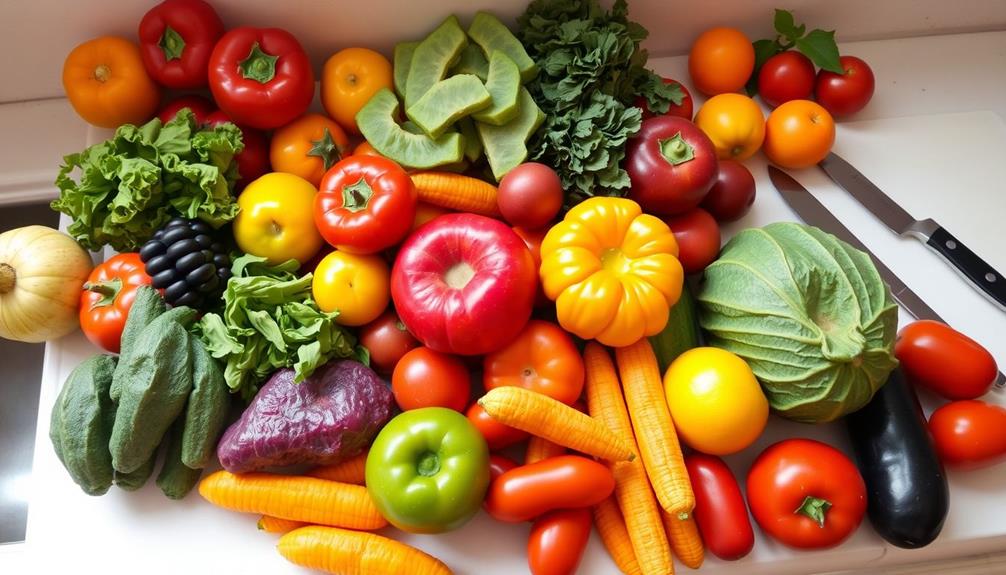
Safe food handling practices are vital for anyone preparing raw foods, as they help reduce the risk of harmful bacteria contaminating your meals. Always wash fruits and vegetables thoroughly under running water before consumption. This simple step can markedly limit foodborne illnesses.
Additionally, incorporating foods known for their health benefits, such as celery juice, can support your overall well-being. To guarantee food safety, use separate cutting boards for raw meat and other foods. This prevents cross-contamination, which can lead to serious health issues.
When it comes to animal products, cooking them to specific internal temperatures is essential. For example, fish should reach 145°F, while ground meats need to hit 160°F. This process eliminates harmful pathogens that could cause diarrhea and other gastrointestinal problems.
Regularly clean surfaces and utensils that come into contact with raw foods. This minimizes bacterial contamination and makes your kitchen a safer place. After cooking, refrigerate dishes promptly and reheat leftovers to at least 165°F before eating. This practice prevents the growth of bacteria that can lead to foodborne illnesses.
Conclusion and Recommendations
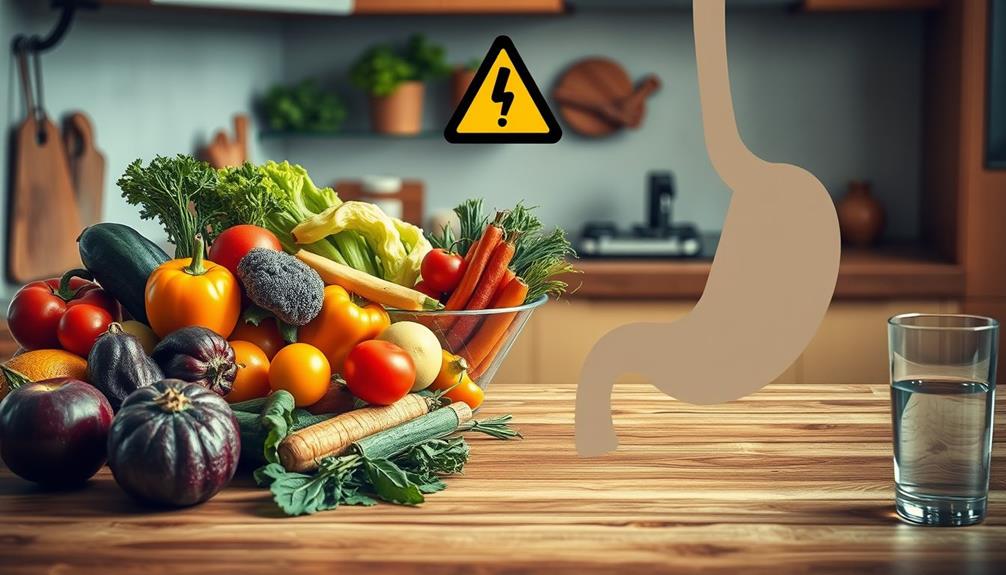
While the appeal of raw foods can be tempting, it's important to recognize the potential risks involved. Consuming raw food exposes you to harmful bacteria and parasites, greatly increasing your risk of foodborne illnesses, including diarrhea. High-risk items like sushi, raw oysters, and undercooked pork can harbor dangerous pathogens such as E. coli and Salmonella.
To reduce this risk, always cook animal products to the recommended internal temperatures—165°F for poultry and 145°F for fish. If you do choose to eat raw fruits and vegetables, wash them thoroughly to minimize bacterial contamination.
It's particularly vital for vulnerable populations, including children, pregnant women, and the immunocompromised, to avoid eating raw foods altogether. The consequences of consuming contaminated raw food can be severe, leading to serious health complications.
Frequently Asked Questions
Can Raw Food Cause Diarrhea in Humans?
Raw food can definitely cause diarrhea in you. Consuming items like raw meats, eggs, or unwashed vegetables exposes you to harmful bacteria and parasites, increasing the risk of gastrointestinal issues and foodborne illnesses. Additionally, raw food can also cause constipation in some individuals. This is because certain raw foods are harder for the body to digest, leading to slower bowel movements and potential blockages. It is important to be mindful of the potential effects of consuming raw food and to take necessary precautions to minimize the risk of digestive discomfort. Can raw food cause constipation? It certainly can for some people, so it’s important to pay attention to how your body reacts to different food choices.
What Are the Dangers of a Raw Food Diet for Humans?
Imagine feasting on nature's bounty, but beware! A raw food diet can expose you to harmful bacteria, anti-nutrients, and pesticide residues that might lead to severe digestive distress and foodborne illnesses. Stay cautious and informed!
Is Diarrhea Caused by Raw Meat?
Yes, raw meat can cause diarrhea due to harmful pathogens like Salmonella and E. coli. Cooking meat properly eliminates these risks, so always guarantee you cook your meat to the recommended temperatures for safety.
What Infection Can You Get From Raw Food?
You can get infections like Salmonella, E. coli, and Listeria from consuming raw animal products. Raw seafood can expose you to vibriosis and hepatitis A, while undercooked pork may lead to trichinellosis. Always be cautious!
Conclusion
So, if you're itching to go full-on raw, just remember: your salad might be plotting against you, and that sushi could have a hidden agenda. Eating raw can be a wild ride, but don't let your stomach turn into a rollercoaster. Stick to safe handling practices, and maybe save the daring culinary adventures for when you're not in the mood for a bathroom marathon. After all, nobody wants to play hide-and-seek with foodborne illness!

